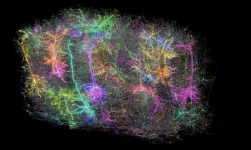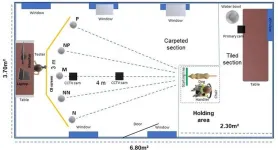Scientists map unprecedented detail of connections and visual perception in the mouse brain
NIH-funded project helps unraveling the brain’s wiring, giving clues to how we see the world
2025-04-09
(Press-News.org) What: In a massive scientific effort funded by the National Institutes of Health (NIH), hundreds of researchers have helped to map the connections between hundreds of thousands of neurons in the mouse brain and then overlayed their firing patterns in response to visual stimuli. This breakthrough is a critical piece of foundational science to build toward understanding how our brains process visual information to reconstruct the images we see every day.
Information processing in the human brain occurs via electrical firing of 86 billion neurons that make trillions of connections with each other. The secrets of how our brain enable us to think, feel, and act lie hidden in the complexity of its wiring diagram and the barrage of electrical signals that move across it in millisecond time frames. While the current findings focus on a tiny fraction of the brain, they reveal the complex connections between the cells and show how those connections are wired to produce functional responses. This information, which was previously beyond our reach, could help us understand how the brain functions normally and offer a guide to what goes wrong as the result of various disorders or injuries.
To carry out the study, researchers presented video clips to mice genetically engineered for their neurons to emit light when they fire. The neuron firing patterns in areas on the brain surface that are associated with vision were optically recorded across a cubic millimeter - about the size of a grain of sand. Within this deceptively small amount of tissue lies remarkable complexity: four kilometers of axons, the processes that nerve cells use to communicate with each other, intertwined to make more than 524 million connections called synapses across more than 200,000 cells.
To map these connections teams worked 12-hour shifts for 12 straight days to carefully cut and image ultra-thin slices of the brain tissue using electron microscopes (EM). Reconstruction was the most challenging next step, as it required accurate stitching together almost 28,000 EM images to align the connections that cross the volume of brain tissue. This was followed by months of tracing the connections using deep learning algorithms followed by manual, and automated proofreading. Deep learning predictive models that explain visual information processing in the cortex were constructed and validated. In total, the sheer amount of data collected to create this tiny map comes out to 1.6 petabytes, roughly the equivalent of 22 years of continuous HD video.
These results come at a time when maps of neurons and their connections are increasingly revealing the mysteries of the brain. In 2023, research funded by the National Institutes of Health Brain Research Through Advancing Innovative Neurotechnologies® Initiative, or The NIH BRAIN Initiative®, produced the first complete cell atlas of the mouse brain, including the types and locations surveyed from more than 32 million cells. Last year, the NIH BRAIN Initiative “Flywire” project led to the complete mapping of the common fruit fly brain, demonstrating the unique value of mapping the whole brain in its entirety.
Funding for this project was provided through the Machine Intelligence from Cortical Networks (MICrONS) Program of the Intelligence Advanced Research Projects Activity and the NIH BRAIN Initiative. The findings, published in a package of 10 papers published in the Nature family of journals, represent more than seven years of work performed by more than 150 scientists around the world.
The mouse connectome data detailed in this press release can be visualized online using the MICrONS Explorer resource.
Who: John Ngai, Ph.D., director of The NIH BRAIN Initiative, is available for comment.
Article: The MICrONS Consortium et al. papers can be found here.
###
The NIH BRAIN Initiative, a multidisciplinary collaboration across 10 NIH Institutes and Centers, is uniquely positioned for cross-cutting discoveries in neuroscience to revolutionize our understanding of the human brain. By accelerating the development and application of innovative neurotechnologies, The BRAIN Initiative® is enabling researchers to understand the brain at unprecedented levels of detail in both health and disease, improving how we treat, prevent, and cure brain disorders. The BRAIN Initiative involves a multidisciplinary network of federal and non-federal partners whose missions and current research portfolios complement the goals of the NIH BRAIN Initiative.
About the National Institute of Neurological Disorders and Stroke (NINDS): NINDS is the nation’s leading funder of research on the brain and nervous system. The mission of NINDS is to seek fundamental knowledge about the brain and nervous system and to use that knowledge to reduce the burden of neurological disease.
About the National Institutes of Health (NIH): NIH, the nation's medical research agency, includes 27 Institutes and Centers and is a component of the U.S. Department of Health and Human Services. NIH is the primary federal agency conducting and supporting basic, clinical, and translational medical research, and is investigating the causes, treatments, and cures for both common and rare diseases. For more information about NIH and its programs, visit the NIH website.
END
[Attachments] See images for this press release:


ELSE PRESS RELEASES FROM THIS DATE:
2025-04-09
In 1962, when environmentalist and author Rachel Carson penned Silent Spring, alerting the world to the dangers of the pesticide DDT, it was the reproductive threat to birds – the bald eagle in particular – that spurred people to action.
Six decades later, Rutgers University–New Brunswick researchers are taking the measure of another global environmental pollutant by drawing parallels to the crisis Carson identified. This time, the pollutant is mercury, and the sentinels are penguins living in the farthest reaches of the Antarctic Peninsula.
“With mercury, there’s an analogy to DDT,” said John Reinfelder, a professor in the Department of Environmental Sciences ...
2025-04-09
Before humans can colonize the moon or Mars, scientists and engineers must first develop techniques for building permanent structures and pressurized habitats in harsh, thin-atmosphere and low-gravity environments.
Dr. Wei Li, an assistant professor of mechanical engineering in the Erik Jonsson School of Engineering and Computer Science at The University of Texas at Dallas, is developing a virtual lunar welding platform to troubleshoot assembling large structures in such conditions.
“As we try to return to the ...
2025-04-09
Higher firearm violence in neighborhoods is linked to lower rates of people going to the dentist and higher rates of total tooth loss, known as edentulism, according to Rutgers researchers.
Their study, published in the American Journal of Preventive Medicine, used data from the Centers for Disease Control and Prevention for dental care utilization and complete loss of teeth and data from the American Violence Project for firearm violence incidents. The researchers examined 20,332 census tracts within the 100 largest cities in the United States from 2014 to ...
2025-04-09
A new approach to streaming technology may significantly improve how users experience virtual reality and augmented reality environments, according to a study from NYU Tandon School of Engineering.
The research — presented in a paper at the 16th ACM Multimedia Systems Conference on April 1, 2025 — describes a method for directly predicting visible content in immersive 3D environments, potentially reducing bandwidth requirements by up to 7-fold while maintaining visual quality.
The technology is being applied in an ongoing NYU Tandon National Science Foundation-funded project to bring point cloud video to dance education, making ...
2025-04-09
EMBARGOED FOR RELEASE UNTIL 4:00 P.M. ET, WEDNESDAY, APRIL 9, 2025
MINNEAPOLIS — Heavy drinkers who have eight or more alcoholic drinks per week have an increased risk of brain lesions called hyaline arteriolosclerosis, signs of brain injury that are associated with memory and thinking problems, according to a study published on April 9, 2025, online in Neurology®, the medical journal of the American Academy of Neurology. The study does not prove that heavy drinking causes brain injury; it only shows an association.
Hyaline arteriolosclerosis is a condition that ...
2025-04-09
EMBARGOED FOR RELEASE UNTIL 4:00 P.M. ET, WEDNESDAY, APRIL 9, 2025
MINNEAPOLIS — While some studies have suggested that having a mother with Alzheimer’s disease may put you more at risk of developing the disease, a new study finds that having a father with the disease may be tied to a greater spread of the tau protein in the brain that is a sign of the disease, according to a study published on April 9, 2025, online in Neurology®, the medical journal of the American Academy of Neurology. The study does not prove that having a father with Alzheimer’s results in these brain changes; it only shows an association.
The study also showed ...
2025-04-09
Why this matters:
Arsenic levels in brown rice were found to be higher for U.S. consumers than in white rice, despite people often looking to brown rice as a healthier alternative.
There is significant arsenic risk for U.S. children under 5 who consume brown rice, as arsenic is a toxic chemical element that can lead to health problems.
Arsenic levels in U.S.-grown rice were found to be considerably lower than rice grown outside the country, suggesting there is concern to U.S. consumers who eat rice grown outside the country.
EAST LANSING, Mich. – Whether you buy rice at the grocery store or order a side of it while ...
2025-04-09
A new, exploratory study has revealed statistical links between the performance of medical detection dogs and their scores on behavioral and affective tests, finding that more “optimistic” dogs tended to perform better overall on detection tasks, but “pessimistic” dogs had higher scent detection specificity. Sharyn Bistre Dabbah of the University of Bristol, U.K., and colleagues present these findings in the open-access journal PLOS One on April 9, 2025.
Animal researchers commonly use a method called judgment bias testing to help assess animals’ emotional states. For example, dogs may first be trained to associate a specific location in a room ...
2025-04-09
In a new study, wastewater surveillance for multiple pathogens at five different sites identified local trends that were not captured in larger surveillance programs, and some sites used the data to inform efforts to prevent disease spread. Jay Bullen of Untap Health in London, U.K., Charlotte Hammer of the University of Cambridge and colleagues present these findings in the open-access journal PLOS Global Public Health.
People with viral infections produce waste containing viral RNA that ends up in wastewater ...
2025-04-09
Scientists from Yale University report that in addition to participation in school-based extracurricular activities, U.S. adolescents who participate in faith-based or community-based extracurricular activities may be more likely to identify the risks of binge-drinking behavior, which could be an important consideration when developing preventions for excessive alcohol consumption.
###
Article URL: https://plos.io/4jHh7Dd
Article Title: Adolescent extracurricular activities and perception of risk of harm from binge drinking
Author Countries: United States
Funding: This study was financially supported by the National Institute on Drug Abuse (NIDA) (https://nida.nih.gov) ...
LAST 30 PRESS RELEASES:
[Press-News.org] Scientists map unprecedented detail of connections and visual perception in the mouse brain
NIH-funded project helps unraveling the brain’s wiring, giving clues to how we see the world





